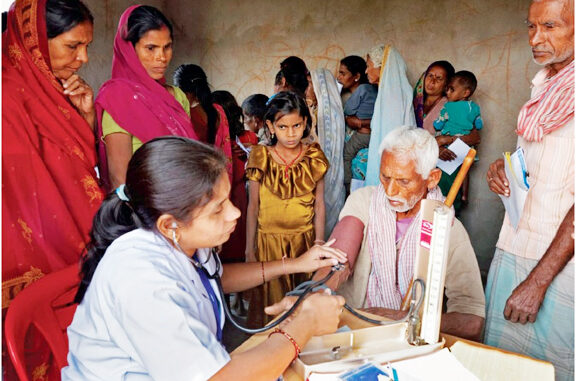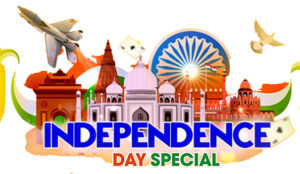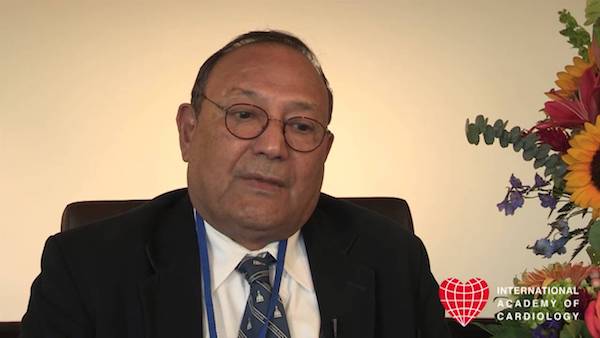
India in 2022 and India in 1947 are stark reminders of how a country evolves and survives the test of time. In the last 75 years, India has emerged with new dynamics and has made significant progress in various spheres like the economy, healthcare, education, space, and technology among others. After freeing itself from the clutches of the British rulers, over the next decades India had taken some crucial steps to improve healthcare accessibility and availability. Post-independence India’s most noteworthy achievement, in the public health arena, has been the decrease in death rates (mortality). From launching national-level and ambitious initiatives to reducing and controlling some of the deadly diseases, India has come a long way. Let’s have a look at some of the important achievements of India’s healthcare system in the last 75 years:
British rulers, over the next decades India had taken some crucial steps to improve healthcare accessibility and availability. Post-independence India’s most noteworthy achievement, in the public health arena, has been the decrease in death rates (mortality). From launching national-level and ambitious initiatives to reducing and controlling some of the deadly diseases, India has come a long way. Let’s have a look at some of the important achievements of India’s healthcare system in the last 75 years:
Improved Life Expectancy
In 1947, the expectancy of an average Indian citizen was around 32 years and it has increased to 70.19 years in 2022. The increase in life expectancy in the last 75 years has been over 100 percent. United Nations-World Population Perspective states that the average global life expectancy is 72.98 years. According to the World Health Organization (WHO), India has significantly improved its people’s health outcomes. According to experts, life expectancy is one of the most important and most used indicators for human development. Several studies have revealed that India’s life expectancy has increased due to the better availability of treatments, medicines, and evolving technology. The current life expectancy for India in 2022 is 70.19 years which is a 0.33 percent increase from 2021. Experts opine that there have been significant enhancements in infant and child mortality along with maternal mortality that has led to the longevity of life in the country.
Decline in Child, maternal mortality Rate
According to United Nation projections, India’s current infant mortality rate in 2022 is 27.695 deaths per 1000 live births, a 3.74 percent decline from 2021. The findings of the National Health Family Survey-5 (NHFS-5) revealed that IMR has marginally declined in nearly all states and Assam has seen one of the largest drops in IMR, from 48 deaths (per 1,000 live births) to 32 deaths. Meanwhile, in the 1940s, the Maternal mortality ratio (MMR) was 2000/100,000 live births, which apparently came down to 1000 in the 1950s. Moreover, India is also a signatory to the United Nations (UN) Sustainable Development Goals (SDGs), which adopted a global maternal mortality ratio (MMR) target of fewer than 70 deaths per 100 000 live births by 2030. In March this year, a special bulletin by the Registrar General of India the MMR has declined by 10 points. It has declined from 113 in 2016-18 to 103 in 2017-19 which is an 8.8 percent decline.
Control of Communicable Diseases:
Since gaining independence, India has launched several national programmes to curb the menace of communicable diseases like Malaria, Tuberculosis, and AIDS, among others. According to a study published in the American Journal of Tropical Medicine and Hygiene, in 1947, 75 million malaria cases in a population of 330 million were estimated in India. During the eradication era in the late 1950s and early 1960s, a spectacular achievement was witnessed on the malaria eradication front because malaria cases significantly declined to just 100,000 in 1964. Despite the reversal which led to around 6.4 million cases in 1976, the cases of malaria have declined significantly over the year. According to the WHO’s latest World Malaria Report 2021, of the world’s 11 highest burden countries, only India registered progress against malaria. Meanwhile, India’s success in Polio has been acclaimed around the globe. Until the early 1990s, Polio was hyperendemic in India, with an average of 500 to 1000 children getting paralysed daily. India was declared Polio free in 2014 and no new case of Polio has been reported in the country since January 2011. With respect to Leprosy, India is running one of the largest leprosy eradication programme in the world, the National Leprosy Eradication Program (NLEP). India’s performance in smallpox eradication has been commendable too. After years of being one of the countries with the highest number of smallpox cases, the country declared itself smallpox free in 1979. Similarly, India has made significant progress in controlling diseases like Tuberculosis, Cholera, Kala Azhar, and HIV.
Healthcare policies and government schemes:
Since India became independent in 1947, the government has launched various policies and schemes to improve healthcare facilities in the country. Over the decades, the government has launched schemes like National Health Mission (NHM) and National Rural Health Mission (NRHM) to improve child and maternal health. Meanwhile, there are schemes that are launched as a part of these missions including Janani Suraksha Yojana (JSY) enables direct cash transfer to pregnant mothers, Janani Shishu Suraksha Karyakram (JSSK)allows pregnant mothers to deliver in government hospitals for free, Pradhan Mantri Surakshit Matrutva Abhiyan (PMSMA) focuses on providing good antenatal care and specifically identifying and managing high-risk pregnant mothers. In 2018, a centrally-sponsored Ayushman Bharat Pradhan Mantri Jan Arogya Yojana (AB PM-JAY) was launched which is the largest Government funded health assurance/insurance scheme in the world. In this scheme, financial risk protection is provided by the government against catastrophic health expenditure that impoverishes an estimated 6 crore people every year. Moreover, the government has launched several other schemes like Pradhan Mantri Swasthya Suraksha Yojana (PMSSY), enhanced the quality of medical education in the country and the extensive improvement in healthcare infrastructure since independence. With over 92,000 seats, there are now 612 medical colleges in India as compared to 28 in the 1950s.
Educational journey
Institutional and Regulatory Reforms in Independent India
In 1964-66, the education commission made recommendations on different stages of education at national level, which eventually formed the first national education policy of the free-nation in 1968. The policy was revised in 1986, which further emphasised on technology based reforms in educational sectors. Initially the education department functioned under the Ministry of Human Resource and Development, which later in 2020 was named as Ministry of Education under the National Education Policy 2020.
The major bodies of the department of education under MHRD included All-India Council of Technical Education (1945), the University Grants Commission (1953), and the National Council of Educational Research and Training (1961). The first body was meant for advisories of technical education, the second body was in charge of coordination and orders on financial advisories and grant allocations for universities, while the third was significantly responsible for quality of educational contents and their implementation.
Parallely, with the foundation of educational entities, the formation of Indian Institution Technologies (IITs) wrote its own chronicle in the light of upliftment of educational institutions. The first IIT was established in Hijli Detention Camp in Kharagpur, West Bengal in 1951. On September 15, 1956, the parliament passed the Indian Institute of Technology (Kharagpur) Act under the prime ministership of Jawarharlal Nehru, who declared IITs as Institutes of National Importance. Currently India has a total of 23 IITs. With its primary focus on science and technology, IITs have now reformed with the introduction of liberal arts programmes with due course of time.
Journey of Educational Policies
In 1950, a Planning Commission was appointed by the government of India to prepare a blueprint for the development of different aspects of life which included education as well. As a result, the five years plan came into existence with the aim to achieve universalisation of elementary education, eradicate illiteracy from the country, establish vocational and skill training programmes for mass development and raise the standard of education. Further, it aimed to ensure democratisation of education in every strata of the society.
Under this five years plan came several schemes and policies which changed the face of education in India. First in the line was the formation of National Education Policy (1968) which was based on the recommendations of the Kothari Commission- one of the first commissions assigned the task of formulating a policy for the development of education in India. This policy emphasised on three language formulas to be implemented in secondary schools namely- English, Hindi, and regional language. In 1986, National Policy on Education led by Rajiv Gandhi came into existence with the focus on women, scheduled castes (SC) and scheduled tribes (STs), under which, Operation Blackboard was launched to improve primary schools in the country.
Policies such as the Teacher Education Schemes were also introduced by the commissions to train teachers for better imparting of knowledge. The government also started several centrally funded programmes to achieve the goal of universalisation of primary education. With this came Mid-Day Meal schemes which aimed to improve the nutritional status of primary school children. It also promoted parents who send their children to schools. Similarly, the government launched many target specific programmes such as Sarva Shiksha Abhiyan and Padhe Bharat Badhe Bharat to improve education for certain identified sections of children. The Right to Education Act (2009) was an important milestone in the development of education in India which made it a fundamental right of every child to get education.
As the country readies to celebrate 75 years of independence, it is on the verge of implementation of National Education Policy 2020 which emphasises on digitalisation and internationalisation of education in India. The new policy aims to bring several changes in the education system, among which regional language as medium of instruction in schools, a 5+3+3+4 model to optimise learning and paving way for foreign universities in India mark significant ones among others. It is believed that the NEP 2020 offers several new provisions in the Indian education system, the outcome of which is yet to unfold.
Journey of Science & Technological Development
Modern India is an epitome of Scientific and Technological Development and is one of the key elements for economic growth. Post 15th August 1947, India’s journey has become a great example of an impressive growth story. As claimed by the Indian Brand Equity Foundation, India is among the topmost countries in the world in the field of scientific research and has been positioned as one of the top five nations in the field of space exploration. India has continuously undertaken space missions, including missions to the moon and the famed Polar Satellite Launch Vehicle (PSLV). India also ranks third among the most attractive investment destinations for technology transactions in the world. Our First Prime Minister, Pandit Jawahar Lal Nehru said “Science is not merely an individual’s search for truth; it is something infinitely more than that if it works for the community”. He made efforts to convert India’s economy into that of a modern state and to fit her into the nuclear age and do it quickly. As India is celebrating the 75th anniversary of its independence, let’s look what were the major Scientific & Technological developments during this period:
Development of Agricultural Technology
As per the official data, the agriculture sector forms only about 18% of India’s GDP and employs almost 65% of the total workforce. Technology plays an important role in the agriculture and sustainable development of India. Advanced technology helps in developing and improving many areas of agriculture, such as fertilizers, pesticides, seed technology, etc. Let’s look at some of the major milestones of Agriculture Technological Development in India Post-Independence:
1960: Green Revolution
The Green Revolution was an endeavor initiated by Norman Borlaug in the 1960s. He is known as the ‘Father of Green Revolution in the world. It led to him winning the Nobel Peace Prize in 1970 for his work in developing High Yielding Varieties (HYVs) of wheat.
1970: White Revolution
Operation Flood, launched on 13 January 1970, was the world’s largest dairy development program and a landmark project of India’s National Dairy Development Board.
Development of Defence Technology
Dr. Homi Bhabha has played a major Role in the Development of Defence Technology in India after Independence. India has been attacked many times by its neighbors. India has faced many wars including Indo China War and Indo-Pakistan War and has also won many battles. Let’s look at some of the major milestones of Defence Technological Development in India Post-Independence:
1958: DRDO was set up
The Defence Research and Development Organisation (DRDO) was set up in 1958 to secure the borders of India with more advanced Defence Technology. Since then, DRDO has developed several large programs and essential technology, including aircraft, small and large arms, artillery systems, electronic warfare (EW) systems, tanks, and armored vehicles, sonar systems, command and control systems, and missile systems.
1989: Agni Missile was successfully launched
Agni-I was first tested at the Interim Test Range in Chandipur at 7:17 AM on 22 May 1989 and was capable of carrying a conventional payload of 1,000 kg (2,200 lb) or a nuclear warhead. Agni missiles consist of one (short range) or two stages (intermediate-range).
1998: India conducted Pokhran-II tests
On 11 and 13 May 1998, twenty-four years after Pokhran-I, the Indian Defence Research and Development Organisation (DRDO) and Atomic Energy Commission (AEC) conducted five further nuclear tests, dubbed “Pokhran-II”, at the Pokhran range. The chief scientific adviser and the Director of Defence Research and Development Organisation (DRDO), Dr. Abdul Kalam, and Dr. R. Chidambaram, the Director of the Department of Atomic Energy (DAE), were the chief coordinators of this test planning.
Development of Space Technology
India has initiated some major space research programs under the vision of some great scientists and leaders like C.V Raman, Dr. Vikram Sarabhai, Dr. A.P.J Abdul Kalam, etc. Let’s look at some of the major milestones of Space Technological Development in India Post-Independence:
1963: India’s first-ever rocket launch
The launch of the first sounding rocket from Thumba near Thiruvananthapuram, Kerala on 21 November 1963, marked the beginning of the Indian Space Programme. Sounding rockets made it possible to probe the atmosphere in situ using rocket-borne instrumentation. This was the first milestone in modern India’s space odyssey. Dr. Vikram Sarabhai and his then accomplice Dr. APJ Abdul Kalam were the brainchild of this achievement.
1975: First Satellite Aryabhata launched
Aryabhatta, the first Indian satellite, was launched by the Soviet Union in 1975. The Aryabhata spacecraft, named after the famous Indian astronomer, was India’s first satellite; it was completely designed and fabricated in India and launched by a Soviet Kosmos-3M rocket from Kapustin Yar on April 19, 1975.
1969: Formation of Indian Space Research Organisation (ISRO)
ISRO was formed in 1969 with a vision to develop and harness space technology in national development while pursuing planetary exploration and space science research. ISRO replaced its predecessor, INCOSPAR (Indian National Committee for Space Research), established in 1962 by India’s first Prime Minister Pt. Jawaharlal Nehru and scientist Vikram Sarabhai, are considered among the founding fathers of the Indian space program.
2008: Chandrayaan-1 launch
Chandrayaan-1 was the first Indian lunar probe under the Chandrayaan program which was launched by the Indian Space Research Organisation (ISRO) on October 22, 2008. The mission was a major boost to India’s space program, as our country researched and developed its own technology to explore the Moon.
2013: Mangalyaan launched
The Mars Orbiter Mission (MOM), also called Mangalyaan, is a space probe orbiting Mars since 24 September 2014. It was launched on 5 November 2013 by the Indian Space Research Organisation.
The journey highlights India’s expansion ranging from agricultural production to nuclear and space technology, from affordable health care to world-class educational institutions, from Ayurveda to biotechnology, from giant steel plants to becoming an IT power, and having the third-largest start-up ecosystem in the world.
Indian military strength
With the world facing constant threat from neighboring countries, where the nuclear power decides the authority, with major peacekeeping organizations failing in its duty, the question about how safe is your country and how powerful it is to fight the enemy might strike your mind. The recent Russian-Ukraine crisis is the live example of the fear the world is experiencing for the potential world war 3. Let’s take a look on the report demonstrating India’s military strength in the present day.
India is the 7th largest by area with the 2nd most populous country in the world, also the fastest growing economy in the world. India has a strong potential of being the superpower in the future by having one of the most powerful military strength. It is ranked 4th out of 140 countries With the strength of 1.45 lakh active military manpower. PwrIndx gives it a score of 0.0979. The lower the PwrIndx value, the more powerful a nation’s potential combat capability is. The country has a powerful allies with the global superpowers such as Russia as well as the US
Missile strength of India Anti satellite weapon
India is among the few countries in the world which owns anti-satellite missiles including the US, China and Russia. Anti-satellite weapons are space weapons that are designed to disable or destroy satellites for tactical and operational reasons.
Submarine launched ballistic missile
India successfully tested -fired the K-4 submarine-launched ballistic missile, which has a range of 3,500 km. Only a few countries have managed to achieve this scientific advance. It will provide the country the ability to launch nuclear missiles in Indian waters from a safe distance. Apart from this we have inter continental ballistic missile Agni 5 with the range of 5000-8000 KM, Cruise missile Brahmos with each of them having the latest version with more power in development.
India’s Nuclear capacity
The country currently has 150- 160 active nuclear weapons. India has a nuclear policy of “no first use.” While the country has never utilized its nuclear weapons, it actually prevents neighboring countries from attacking it. While having the triad capability (Nuclear weapons that can be delivered via aircraft, land-based and submarine-launched missiles.) Only a few countries such as the US, Russia, India, and China have this capacity.
Crucial Events That Transformed India’s Economy
As India went through its worst droughts in the 1960s, the nation had to depend on western countries for food and grain supplies. But the crisis led to focus on self sufficiency of food grains and hence, the Green Revolution came into being. Apart from that, the period holds significance as, during this phase, Mrs. Indira Gandhi had nationalised 14 biggest commercial banks. The main aim of the move was to accelerate bank lending to agriculture at a time when big businesses cornered large chunks of the credit flow.
1991: Liberalisation, Privatisation and Globalisation
The journey of the Indian economy is incomplete without this chapter. With the devaluation of the currency, rising fiscal deficit of the government (from 9% of GDP in 1980-81 to 10.4% in 1985-86 and 12.7% in 1990-91), India’s external debt nearly doubled from some $35 billion at the end of 1984-85 to $69 billion by the end of 1990-91.
The country’s foreign exchange reserves had dried up to the point that India could barely finance three weeks worth of imports. The situation was so grim that the Indian government had to mortgage some 20 tonnes of gold for $240 million, just to keep the economy afloat.
On the political front, the Chandra Shekhar government gave way to another Congress government, as the party made a comeback after two years. Enter PV Narsimha Rao as prime minister and Manmohan Singh as finance minister. Within weeks of assuming power, Rao and Singh announced a series of policies that changed the face of Indian economy– liberalisation, privatisation and globalisation.
These reforms helped the country get freedom from the tough bureaucratic system and opened the doors for more opportunities and foreign financial inflows. Moreover, it led to the boom in stock markets.
The Global Crisis of 2007-08 and Its Impact on India:
The “Great Recession” , an epic financial and economic collapse that brought the whole of Wall Street to its knees was led by the largest bankruptcy in U.S. history– the collapse of Lehman Brothers. While the other countries were facing the worst, economic growth in India during FY2008-09 stood at 6.7%. Reportedly, India was less impacted because the exports accounted for just 15% of the GDP.
But, what came in as a surprise was the stimulus package announced by the Manmohan Singh administration. In December 2008, the government decided to seek approval for an additional plan expenditure of Rs 200 billion. “The government also infused about Rs 3 trillion into the system for public spending through a range of measures such as lowering tax and reduction of key rates by the Reserve Bank of India”, stated an Economic Times report.
Moreover, this package did not go well for the government. “My government was punished in the 2014 elections after we spent more money in 2009 as part of a stimulus package. Due to this, we had to violate fiscal consolidation norms. The inflation went up to 14% and the rupee lost its value. Finally, people rejected our government”, P Chidambaram, the finance minister at the time, was quoted as saying.
Apart from the economy, the Sensex tumbled from more than 20,000 points in Dec 2007 to a little over 9,000 (lowest) in mid-early 2009, before bouncing back to 17,000 in the same year.
2016: Demonitisation
After eight years, the word “demonetisation” was introduced in the annals of India’s economic history. Prime Minister Narendra Modi on November 8 of that year declared that Rs 500 and Rs 1,000 notes would not be legal tender. The announcement shook the country, almost everyone from a small vendor to a high-profile businessman was affected. Sensex crashed nearly 1,689 points and Nifty plunged by over 541 points due to the government’s move to withdraw notes of higher denominations.
Just months after demonetisation, the Rajya Sabha (Upper House) passed a crucial bill on Goods and Services Tax (GST). However, at that time, the markets didn’t react much and remained mostly flat on the upper side.
2020: Virus hits the economy
But, after nearly three years, the country witnessed another jolt: the coronavirus pandemic. According to a report by Azim Premji University, the first wave of COVID-19 pandemic pushed 23 crore people below the poverty line (below the national minimum wage threshold of Rs. 375 per day as recommended by the Anoop Satpathy Committee). The report said there has been a rise of 15% in poverty in rural India and a rise of 20% in urban India during the last one pandemic year. However, after the second wave, it is still unclear how deep the impact of the pandemic would be on the country’s economy. Despite that, the Sensex touched an all-time high of 55,000 and Nifty at 16,529, giving hopes for better and improved days ahead.





Be the first to comment